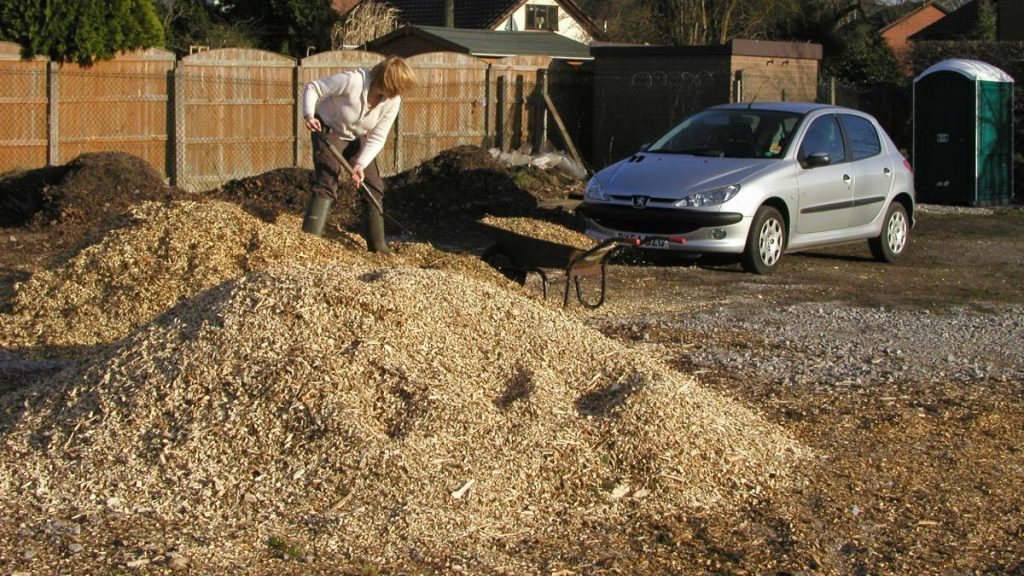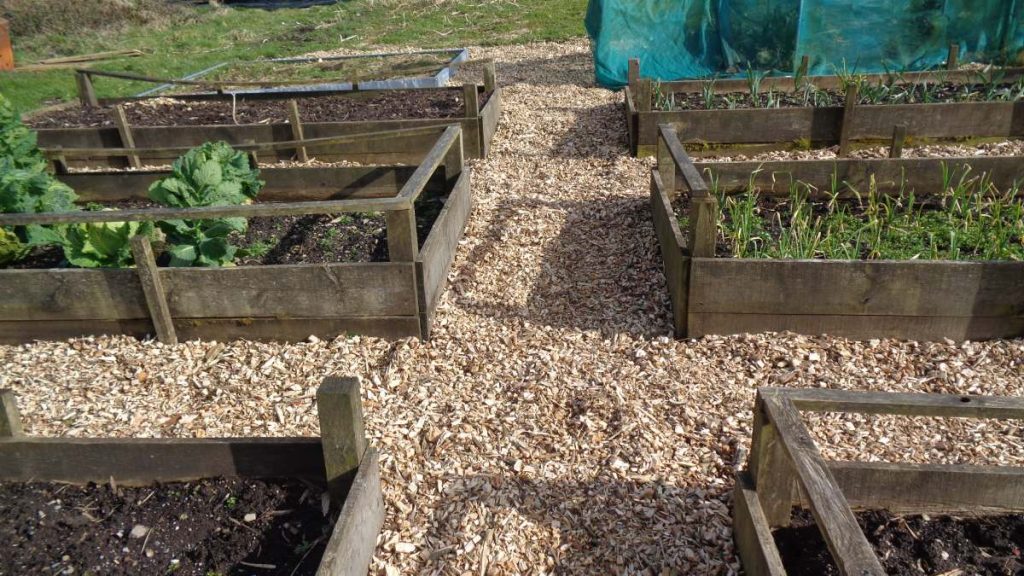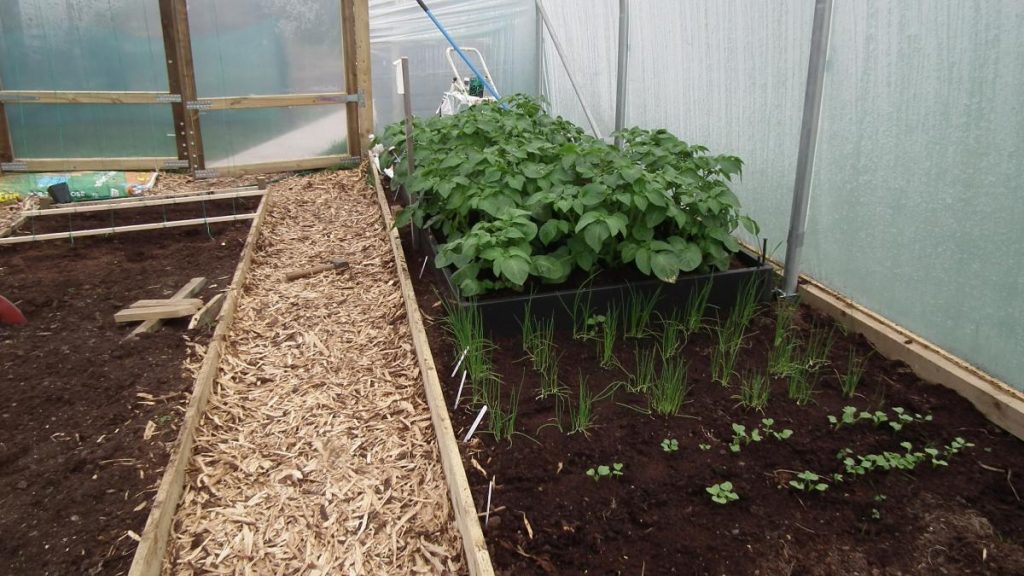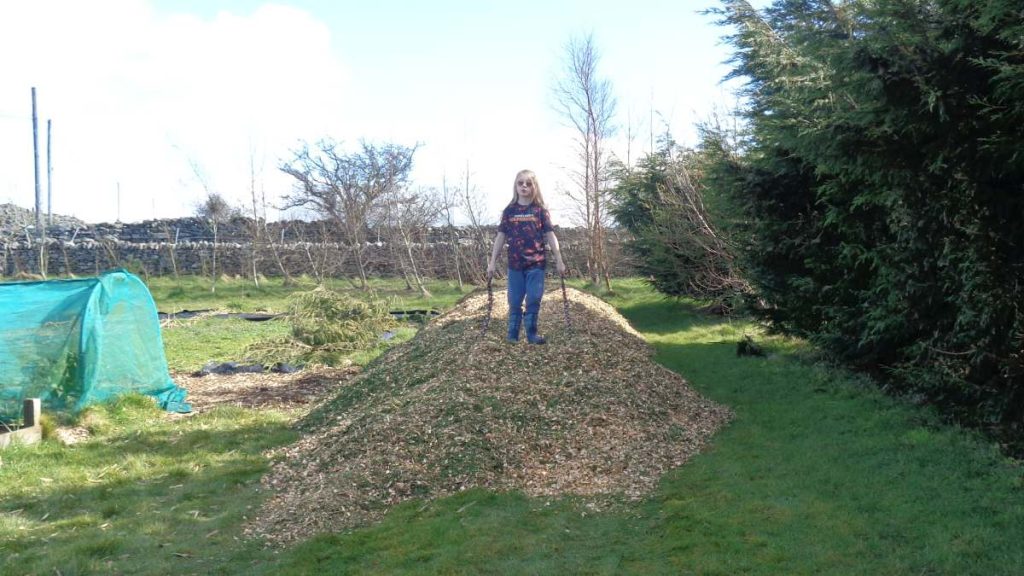Woodchips have a useful role to play in the garden and on the allotment. They’ve formed an important part of my gardening for many years. However, the benefits of woodchips are often overstated and they can cause problems if used incorrectly.
Nutritional Value of Woodchips
NPK value of woodchips have negligible nitrogen, little phosphorus with some potassium (potash). The levels of phosphorus and potassium vary according to the type of trees and age of the trees comprising the woodchips. Burning wood to produce ash concentrates the potassium and wood ash can be a very good source of potassium for gardeners. Be aware that wood ash can increase the pH which may not be desirable with chalky soils.
There are tiny amounts of trace elements such as calcium, magnesium, phosphorus, iron, zinc, copper, manganese and boron, depending on the source and quality of the wood. These are not significant.
Woodchips are composed mainly of cellulose, hemicellulose and lignin, which are organic molecules made up of carbon, hydrogen and oxygen. Oxygen is available from the air and hydrogen from water (H2O) so easily available to plants. It is in the carbon contribution to the soil where the main nutritional value of woodchips lies.
The Value of Carbon in Soil
Carbon isn’t a direct nutrient for plants like nitrogen or potassium but it is a critical component for soil health and overall ecosystem function. A healthy soil grows healthy plants.
Carbon is a key component of organic matter in soil. Organic matter, derived from plant and animal residues, contributes to soil fertility by providing a source of nutrients for plants. This organic matter helps to bind soil particles together, promoting the formation of aggregates. Soil aggregates improve water infiltration, root penetration, and aeration, creating a favourable environment for plant growth.
Organic matter also improves the water-holding capacity of soil. Soils with higher organic carbon content can better retain water, reducing the risk of drought stress for plants.
Soil carbon is vital for soil microorganisms. Microorganisms, including bacteria and fungi, decompose organic matter, releasing nutrients in a form that plants can absorb. This microbial activity is essential for nutrient cycling and soil health.
There are symbiotic relationships between fungi and plants, the fungi provide needed nutrients for the plants and the plants reward fungi with nutrients the fungi needs. A good indicator of a soil being carbon rich is if it produces fruiting bodies (mushrooms) on the surface in autumn.
How woodchips add carbon to the soil
Woodchips need to be broken down into their chemical components to add their carbon to the soil. This is mainly accomplished by soil bacteria which produce enzymes to break down the woodchips into simpler compounds. To do this the woodchips basically need to be in contact with the soil.
Nitrogen robbery effect of woodchips
The bacteria need nitrogen, which they obtain from the soil or from the air. The bacteria use nitrogen to synthesize amino acids, proteins and nucleic acids, which are essential for their growth and reproduction. As the bacteria consume nitrogen, they reduce the amount of nitrogen available for plants, which also need nitrogen to make amino acids, proteins and nucleic acids. This is the nitrogen robbery effect, which can cause plant growth to be stunted, wilted or yellowed.
However, the nitrogen robbery effect is limited to the surface layer of the soil, where the woodchips are decomposing. The surface layer of the woodchips resists decomposition as the only bacteria that can break them down at that surface have to be able to fix nitrogen from the air, which means they can convert atmospheric nitrogen into ammonia or nitrate, which are forms of nitrogen that plants can use.
If new woodchips are dug into the soil they will rot down but they’ll use up the nitrogen in the soil as they do it. This will have a detrimental effect on the soil ecosystem as well as any plants until the balance is restored.
Weed Suppression With Woodchips
A 3 to 5 cm layer of woodchips will be quite effective at suppressing weeds. Weed seeds germinating just under the surface of the soil are weakened or killed by the lack of nitrogen as described above. Light is excluded by the woodchips which also prevents growth. Airborne weed seeds are not going to be able to find a home in the woodchips.
Perennial weeds such as dandelions will break through a woodchip layer. They use the energy stored in their roots and nitrogen from deeper down in the soil to power the growth through that layer.
A layer or layers of cardboard under the woodchips will further improve the effectiveness of a woodchip mulch. The cardboard places a more consistent barrier between the soil and the air. The carbon value of cardboard is very similar to woodchips. Breaking down the cardboard will also deplete nitrogen.
Any weeds that do manage to grow through the woodchips are easier to hoe off or pull.
Woodchips for paths
Woodchips are a cheap way to create paths. They effectively suppress weeds as already covered and in wet weather provide a mud-free surface to walk on.
Over time the path will rot down, creating carbon and humus rich soil. There will be some small spread to the sides but in practice any nitrogen robbery is not really a problem. Adding another layer of woodchips on top of the old each year will maintain the path.
The decomposition of the woodchips is actually a benefit. Often a permanent path isn’t required or a change of mind means a path needs to be moved. Rake off the top layer and use as the base of the new path.
The soil under the path is actually improved with a rich biodiverse microbial ecosystem and high population of earthworms. As a result, incorporating this humus-rich soil into a vegetable plot or decorative border will improve the land.
Woodchip mulches and water retention.
Like many mulches, woodchip mulches assist in the retention of water by breaking capillary action and stopping evaporation. When it does rain, the mulch helps prevent run-off and allows the water to infiltrate the soil below.
Woodchip mulches for perennial plants.
Deep rooted perennials, bushes and trees will benefit to a degree from a woodchip mulch reducing weed competition. With undemanding plants that don’t need annual feeding, a woodchip mulch will look attractive and save maintenance time.
With perennials like blackcurrants that benefit from annual feeding, woodchip mulches are not beneficial. Applying compost requires the mulch to be removed and replaced. Applying artificial fertilisers to the woodchips is only partially effective. Any nitrogen rich fertiliser will be grabbed by the microbes to break down the wood on its way to the deeper soil.
Mulching vegetables and annuals with woodchips.
Just as woodchip mulches prevent weed growth they will prevent vegetables and annuals from growing. Direct sown vegetables are not going to grow and transplanted plants like brassicas are going to be retarded by nitrogen robbery.
Woodchip mulches and pests
Woodchips provide cover for slugs and snails. The mulch keeps moisture below the surface, a perfect environment for slugs. Damp, dark and hidden from birds. Woodchips also encourage earwigs which can be a problem with some crops.
Ants, particularly red ants, seem to like woodchips. Generally ants are more a problem for the gardener than the garden but they do cause problems when they farm aphids on broad beans etc.
Composting Woodchips
Woodchips can have value when mixed composting. The high carbon ratio is useful for balancing nitrogen rich materials. The ideal C:N ratio for composting is between 25:1 and 40:1. Woodchips have a C:N ratio between 400:1 and 800:1 depending on the type of wood, age and moisture content.
The size and shape of the individual woodchips helps keep the decomposing mixed compost open enabling better aeration. This significantly increases the temperature achieved and speed of composting.
Composting woodchips on their own is difficult and slow. Woodchips don’t absorb water well so good for mulching but not for composting. The large particle size doesn’t help. Microbial actions take place on the surface of the materials being composted. The larger the volume, the less surface area as a ratio to volume. That is why shredded materials compost faster.
Adding large quantities of high nitrogen materials (fertilisers) and keeping the woodchips damp will increase the speed of composting. However, it’s still a lengthy and time consuming process. It’s easier to just use woodchips on paths and as a mulch around perennials, allowing them to rot down at their own pace.
If you have a large volume of woodchips then just leave in a pile to rot down. It may take three or four years but eventually they will just become humus rich soil. No effort, just time.
Woodchips and poultry
If you keep poultry then woodchips are ideal for their run. Poultry and pigeon manure is extremely strong, high in nitrogen. The woodchips’ carbon is, to some degree, balanced by the manure’s nitrogen. The woodchips still take time to decompose but they absorb the ammonia from the manure and keep the run relatively sweet.
Partially decomposed woodchips can be added to a mixed material compost when cleaning out the run. Treat as a ‘brown’ as they’ll still be have a fairly high amount of carbon.
Conclusion
Woodchips are a valuable resource for gardeners and woodchip mulches provide a number of benefits. They suppress weeds reducing the gardener’s workload and add to the carbon in the soil improving its ecology, health and nutrient availability.
Used incorrectly woodchips can unbalance the soil ecology and cause a temporary nitrogen deficit. As a result, plant growth may be stunted, wilted or yellowed or they even not grow at all. This is not permanent and will rectify in a season.







